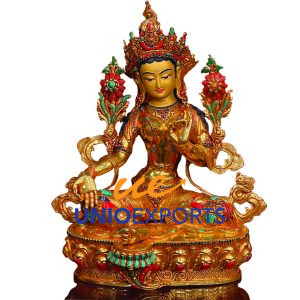Namaste! Unlock Your COUPON
Upto 20% Discount
Sign up to get a discount on your next order
$3,000 – $3,400
As much as the people adhering to the Formalistic School of Thought of Buddhism like to believe that the practices inherently have a stoic quality to them, as was ostensibly preached by Buddha, they couldn’t possibly be further from the truth. Buddha himself never insinuated stoicism as a necessary quality to possess in order to follow his teachings. Buddha had the very human quality of being moved by emotions and feelings and letting them be the driving factors to one’s actions. It doesn’t contradict rationalization, but rather finds the balance between thoughts and emotions, and understanding reactions as largely situational.
Similarly, some deities are peaceful, some are slightly frowning, whilst some are burning with rage. They represent Buddha’s own human-like spectrum of emotions, and they are supposed to resonate with the practitioner, who is also a human. Likewise, human goes through all kind of thought processes and behavioral states. Therefore, along with a peaceful Buddha, a wrathful deity is important to guide the practitioner and protect them from the consequences of their waywardness. Mahakala, the Great Black One, is such a wrathful deity. Mahakala embodies enlightened rage as well the divine protection that we need from our own minds. He is an emanation of the great Avalokiteshvara.
Mahakala is a protective deity, so he holds various ritual implements in his six hands to carry out his protective functions. The first right-hand holds a curved knife that cuts the ego attachment, and the left-hand holds a skull cup that shows his subjugation of evil-doers. This combination of the knife and the cup is the tantric union of method and wisdom as it represents the inseparability of bliss and emptiness.
The other right hands hold a rosary of skulls and a damaru that symbolize his continuous activity for the benefit of beings, and the control over all classes of Dakinis respectively. It is recognized that the damaru also makes the sound that arises us from our ignorance. The remaining left hands hold a trident and a lasso, where the trident symbolizes his power over the three spheres of existence, and the lasso with which he binds those who break their vows. The trident also represents the destruction of the three root delusions, and the lasso is that which reigns in the caprices of the confused mind.
The left leg is outstretched in Mahakala’s iconography, like that of some deities. The right leg is bent and it represents his accomplishments for the benefit of others and oneself. And much like other wrathful deities, he tramples on another deity, an elephant-headed one that symbolizes his destruction and dispersal of great obstacles. The elephant-headed quality of the trampled deity can represent wealth and otherworldly desires, and Mahakala’s domination over the deity shows the enlightened transformation of such a worldly trait.
Mahakala takes his stance upon a sun disc that symbolizes his illumination of the darkness of ignorance. This disc itself rests upon a lotus, which shows his undefiled purity. His powerful activities in consuming all the neurotic states of mind are demonstrated through the pores of his body. Clad in a tigerskin loincloth, a snake necklace adorns him as he holds an elephant skin. These three attributes represent Mahakala’s purification of desire, anger, and pride. Mahakala’s possession of the complete qualities of a fully enlightened Buddha can be seen in his other ornaments, by virtue of elaborate imagery.
Best Price with Best Quality from Nepal
Safe packing ,Delivery by International Courier Company with Tracking system, Delivery in 7 Day all over the world.
Delivery:
1. Shipping Services: We utilize UPS/DHL courier services for shipping directly from Nepal to your preferred destination.
2. Customs Duty: We take care customs duty payment on behalf of our customers to ensure a seamless delivery experience.
3. Corporate Partnership: Our partnership with UPS/DHL guarantees efficient and reliable delivery services, ensuring your products reaches you in a timely manner.
4. Tracking Information: Once your order is processed and shipped, we provide tracking information so you can monitor the status of your delivery.
Return Policy:
Returns are accepted within 3 days of receiving your order.
The Mahakala Statue must be returned in its original packaging that includes the SKU barcode.
We reserve the right to refuse returns that do not meet these criteria.
Refunds will be issued in the original form of payment within 14 days of receiving the returned item.
Shipping and handling charges are non-refundable, except in cases where the return is due to a manufacturing defect or an error on our part.
Return Address:
UNIO EXPORTS
Tarkeshwor 5 Lolang Bohoratar ,44600
Kathmandu, Nepal
For any questions or assistance regarding our return policy, please don’t hesitate to contact our customer service team. We are here to ensure your shopping experience with us is nothing short of excellent.
UNIO EXPORTS reserves the right to update or modify this return policy at any time without prior notice.

| Weight | N/A |
|---|---|
| Dimensions | N/A |
| Size | 8, 12, 18, 30, 44 |

All contents and photographs within this website is copyright © by Unio Exports and may not be reproduced without our permission.
WhatsApp us
Reviews
There are no reviews yet.